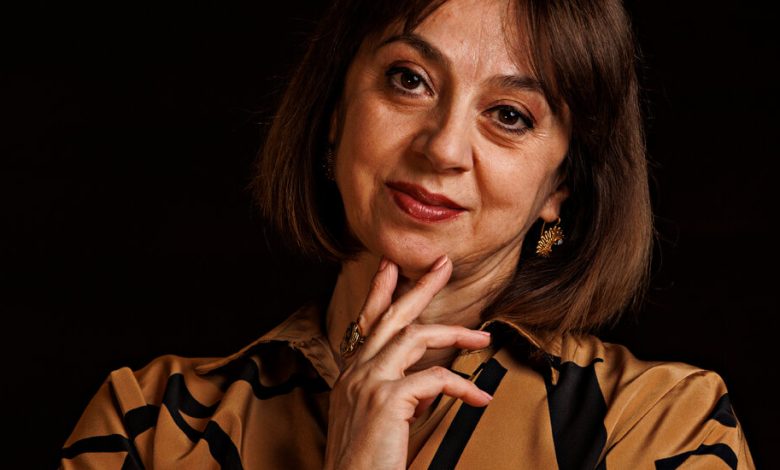‘I Raised Them!’ Nina Ananiashvili’s Georgian Dancers Come to Town

Nina Ananiashvili, a former star of American Ballet Theater, is no tourist to New York City, but she’ll have fun playing one when the State Ballet of Georgia comes to town. As part of a short American tour, the company, led by Ananiashvili, will perform on Sunday at the Lehman Center for the Performing Arts in the Bronx. “We will dance one day, but I will stay a little bit for Valentina Kozlova’s competition,” she said of the international ballet event in a recent video interview. “So I’m a tourist for three days.”
The company — based in Tbilisi, where Ananiashvili was born — presents two masterworks by George Balanchine, “Serenade” and “Concerto Barocco,” along with a homage to Georgia: “Sagalobeli” by the Ukrainian-born Yuri Possokhov. It’s a rare chance to see how Ananiashvili has transformed the company, which she took over in 2004. As for the dancers? “I raised them!” she said. “This is my generation. They are all my generation because they were in the school and then they’re coming to the theater and now they’re dancing ballerinas.”
Ananiashvili, 60, stopped dancing just five years ago herself. “I really have a bad foot, and it was painful to torture myself to go in the pointe shoes,” she said. “I stopped for three months. I said, OK, maybe I’m resting. Then, I was busy and then Covid came. I don’t have any feelings of, Why am I stopping? I’m going to continue what I’m doing.”

The State Ballet of Georgia performing Yuri Possokhov’s “Sagalobeli,” a homage to Georgia.Credit…Lehman Center
And that is teaching, coaching and, of course, running this company, for which she has revamped the repertory to include works by Balanchine, a Russia-born Georgian; Frederick Ashton; Alexei Ratmansky — Ananiashvili was an early champion of his ballets — and more. “I think it’s really important today for classical companies to do classical and some new works and these masterpieces,” she said. “So I try balancing this.”
To Ananiashvili, every company is different, no matter its repertoire. “A company has its own face, and I think we also have our face,” she said. “So we do a lot of maybe different things than what Western people do, like New York City Ballet. But we also love to do Balanchine. It looks a little bit different than some companies do it in the United States, but I think this is always interesting to see. With Balanchine’s work, you need to have it, you need to learn this to improve.”
While at the Bolshoi Ballet, where she was also a principal, Ananiashvili was limited in what she could dance. But then she began to travel and, later, she joined Ballet Theater. “I tried lots of things, and my view was changed, like, oh my God!” she said. “It’s possible like this, it’s possible like that.”
More on N.Y.C. Theater, Music and Dance This Spring
- Jodie Comer Finds Her Light: The one-woman show “Prima Facie” is the “Killing Eve” star’s first stage role. She dared herself to do it.
- Taking on Performative Progressivism: The Native American playwright Larissa FastHorse is making her Broadway debut with “Thanksgiving Play,” a satire about a “culturally sensitive” show.
- Moving Uptown: After starring in a production of “The Sign in Sidney Brustein’s Window,” a long-overlooked Lorraine Hansberry play at the Brooklyn Academy of Music, Oscar Isaac and Rachel Brosnahan are bringing the show to Broadway for a surprise run.
- Unstoppable: John Kander, the 96-year-old composer of “Chicago” and “Cabaret,” is making a brand-new start of it with “New York, New York,” his 16th Broadway musical.
Speaking from Cleveland, where she was teaching the Cleveland Ballet last weekend, Ananiashvili discussed her brief stint at City Ballet, the challenge of being a director and her nonexistent dance practice. “I’m really bad!” she said. But she hasn’t lost an ounce of her humor or her love of dance. What follows are edited excerpts from a recent interview.
In 1988, you were a guest artist with City Ballet. How did that shape you?
It was something very special. At that time it was Peter Martins who invited us [Ananiashvili and the Russian dancer Andris Liepa] to dance and it was like something incredible — it was so hard for me to learn Balanchine, because it was a short time. But at the same time, my mind was open. Ah! You can dance like this.
We stayed for one month, we danced three ballets. I think especially for corps de ballet, it’s something special. I mean, “Concerto Barocco,” it’s much harder for them than for soloists, I think. You need to be in tempo nonstop.
They’re so connected, it’s like a sisterhood.
Yeah! It must be together, and they must feel each other like this. It’s amazing. Every time I’m watching this ballet, I’m thinking, Oh, my God, how genius he was. We are even more proud because he was Georgian, too. [Laughs]
My sadness: If Mr. B would have been alive when I started dancing in New York, I don’t know how my life will be changed.
When you took over as artistic director of the State Ballet of Georgia, it was at the invitation of the president of the country. You had never been a director. Do you feel you are a natural at it?
[Bursts into laughter] No! No, I’m not a natural director, definitely. I’m an artist. And I’m a little bit soft maybe. At the same time, I love to have what I want to have. But I always try to be on the artists’ side, and I’m thinking, so what do they really need?
When you have a lot of people, you need to show them what you want and what your direction is. Generally I don’t have a problem. They respect what I’m doing and they follow me and we go together.
Do you think about being a woman in this job?
No. It doesn’t matter, woman or man. It’s how you’re doing it. This is a difficult job. It depends on the people around you. You cannot do it solo. I have mostly women around me, so I love to have also men, but in Georgia, it’s hard to find it. It’s also that not that many children come to the school. So it’s also sad.
Georgians, they want to go to folk dance, they want to dance Georgian dance. It’s very, very famous in Georgia and very beautiful. But to go to the ballet, first it’s a hard job, but at the same time they’re thinking this is not quite [she makes air quotes] “a man’s job,” you know? It really takes time to change this feeling.
In 2021, you were discussed as the next leader of the Novosibirsk Opera and Ballet Theater in Russia, but it fell through. What happened?
I really don’t want to talk, but I explain the situation: At that time it was Covid and it was a really bad situation everywhere and everything was locked. I thought, I could do co-productions and work together. I thought to help them.
And then it was very hard for me because Georgians really criticized me. It was hard at the time, but I was thinking about dancers more than about myself and about something political at that time. I was just thinking about art and our ballet worlds. And then [Novosibirsk] says yes, they say no problem, please do it like that. And then somehow everything was wrong for me. That’s it.
What do you want to do next with the company and what do you want to do for yourself?
I want to sit in my vineyard. To drink good wine! And enjoy the fantastic view and not be nervous about are the dancers coming tomorrow or not? And are they healthy or not? [Laughs] But I really enjoy what I’m doing. Even thought it’s hard. Sometimes I’m tired.
I had a very great Russian teacher, Raisa Struchkova — like 23 years we were together in the Bolshoi. Then in the 16 years with A.B.T., it was Irina Kolpakova. I’m so thankful to these teachers in my life. And I think it will be very sad if I really enjoy life and do nothing, to not give this to a young generation.
So you keep going.
Every day I’m saying, God, thank you, you gave me these kind of people and I feel like they are really helping me now. What they said to me — sometimes I have this in my ear, even the words that they said to me, how they corrected me, what they taught me. The ballet world is like this. You cannot read books. Of course, it helps. You watch videos. It also helps. But nothing, nothing does the same job.
You need to have the person next to you, to see you, correct you, Because we are human, we are different. So this is our job. And my teacher told me always: “Listen now, you will use this later when you will be teaching.”
How did you react to that?
I was young. I said, my God, I want to dance. What do you mean, I will be teaching? And now, when I’m teaching, I just say: “Remember what I say to you. Remember because when one day you will teach, you will do the same thing like I do now.” This is generation by generation — it goes feet by feet, hand by hand. I think there is no other job like that.
Do you dance at all, or do you have a movement practice?
I’m bad now. [Laughs] You know, every day I say, OK, I need to go a little to practice — for myself — and then something comes up. And I’m so bad. And now when I want to show “you see, you can do it jumping more,” but this is very dangerous now because I put weight on also. I’m not that skinny. I just say it like this: I’m not ballerina now. I am a human now. Normal.



